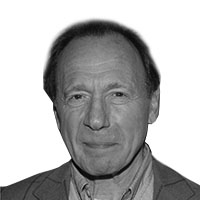Given the charged atmosphere, the attention now being paid to Donald Trump’s early dealings with Roy Cohn, a one-time aide to Senator McCarthy, and a famously connected attorney, isn’t hard to understand.
And the fact that this relationship was forged in Le Club, a swell nightspot of the earlier 70s, takes us to a specific Manhattan nightworld, a nightworld which for deft operators like Cohn and the young Trump could be an extension of the working day.
This was the Manhattan into which I arrived. It’s a time-tunnel moment.
Classics like the Stork Club had become ghost ships. The rivals in the mid-70s were El Morocco, which had opened as a speakeasy at 154 East 54th Street and Le Club, which had only been open for a few years and which was managed by a six foot, four something footer, Patrick Shields.
El Morocco was famous for its zebra-stripey upholstery—stripes which instantly ID’d exactly where a notable face had been photographed—and it was glam.
Le Club had such genteel features as a billiard table, an upstairs dining-room and a fashionably minute dance-floor, and folk likely to show their faces there included showbizzers, like Mike Nichols, who threw an after-Tony party upstairs, and Al Pacino, along with heavyweights in sports, like George Steinbrenner, owner of the New York Yankees, and Roone Arledge, president of ABC Sports. Roy Cohn was a regular.
So the difference between El Morrocco and Le Club was slim but significant.
“I went to El Morocco every night,” one glamor gal told me. ”But I hardly ever went to Le Club. I thought it was a bit creepy.”
But it was at Le Club that Caroline and John Kennedy would throw their joint birthday party there, an event which earned it a footnote in the history of celebrity culture when there was a battle at the door between JFK Jr’s pals and a squad of paparazzi, one of whom happened to be a former marine.
Donald Trump set his sights on Le Club. “Its membership included some of the most successful men and the most beautiful women in the world. It was the sort of place where you were likely to see a wealthy 75-year-old guy walk in with three blondes from Sweden,” he wrote in The Art of the Deal.
But he was a young guy from Queens: “Bridge and Tunnel” in the snotty pejorative shorthand of Manhattan’s clubworld.
Another gal of the time, who was working for Bill Judson, a realtor on the Upper East Side, has vivid early memories of Trump. “He had brown hair then. And it was slicked down with Brylcreem or something” she says. “He would call and ask if he could come over… Bill would say I guess so, yeah …
“Bill would come in and yell Trump’s coming! And we would all run for it… the bathroom, anywhere… Trump would come in and say where are all the girls? Bill would say, well, I warned them you were coming!”
In The Art of the Deal Trump describes his numerous unsuccessful attempts to get into Le Club, and his ultimate success, and, once in, he was very much in. “Trump was a very, very big Le Clubber,” says a financier, himself a regular, whose father worked both for Onassis and with Roy Cohn, who he describes as “absolutely fearless.”
Trump also wrote about finding himself at the next table to Cohn in Le Club. This was 1973. The Trump Organization had been slapped with a suit by the Department of Justice, charging that they had violated the Fair Housing Act, by refusing to rent “because of race and color.”
There was other stuff, including that they had misrepresented to blacks that apartments were not available.
The Trump Organization’s current lawyers were advising them to settle. Roy Cohn took the case. And the company and the government did come to an agreement.
Wayne Barrett wrote in a two-parter piece that was published in the Village Voice in 1979: Finally, Trump has retained Roy Cohn as advisor on each of his major deals, on a host of legal actions, and as a conduit to the upper reaches of power—public and private.
This including getting a tax abatement when Trump tore down the Bonwit Teller flagship store in 1980 in order to erect Trump Tower.
In 1988, two years after Roy Cohn died of AIDS, The Autobiography of Roy Cohn, a book written by a tough-guy columnist, the late Sidney Zion, very much channeling its subject, casts further light on the close business relationship.
Zion writes of “a famous 747 flight.” Cohn had chartered a plane on credit and flown to Europe with a bunch of guys.
What ensued was clearly an airborne, gay version of the Led Zeppelin’s goings-on in a Hyatt Hotel suite.
“The cabin was trashed,” Zion wrote, “the seats broken, the whole thing wrecked like the victim of a gang-rape.”
The airline sued. And won. Roy Cohn kept no money in his account as a business policy. They couldn’t collect.
An executive from the line called Donald Trump. Could he pay something, being that he was both a client of Cohn’s, and a friend?
Trump said, “Are you kidding?”
“I felt for the poor bastard” he told Sid Zion. “Because Roy just wiped out that plane. But what was I supposed to do? Hey, it was Roy, what’s anybody supposed to do? They couldn’t get anything from him, and this guy kept telling me, “We’ve won in every court, every court!”
In 1989, Patrick Shields celebrated his twenty-fifth year as manager of Le Club.
The following year Shields let it be known that he had AIDS.
He was fired, despicably, and in due course died. Le Club did not long survive him.






